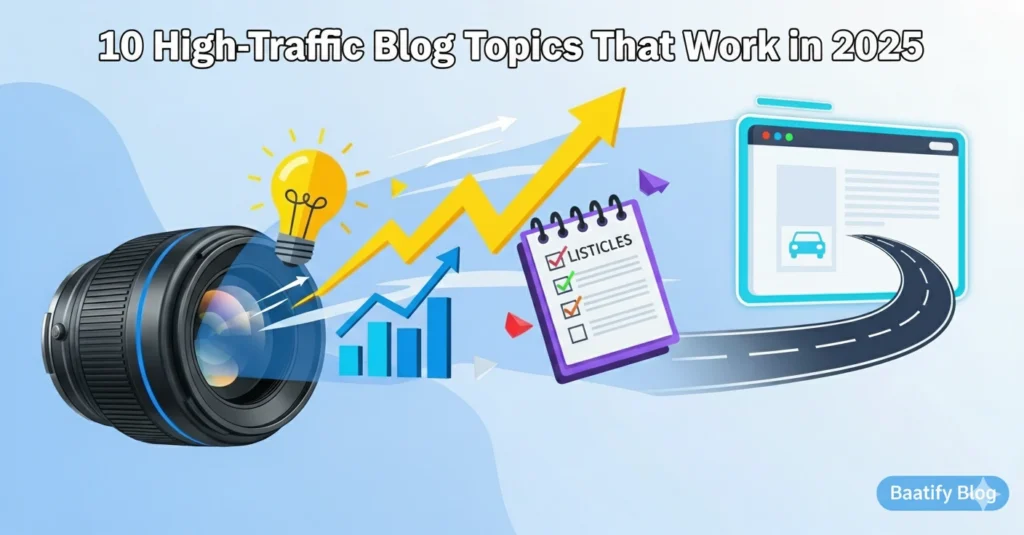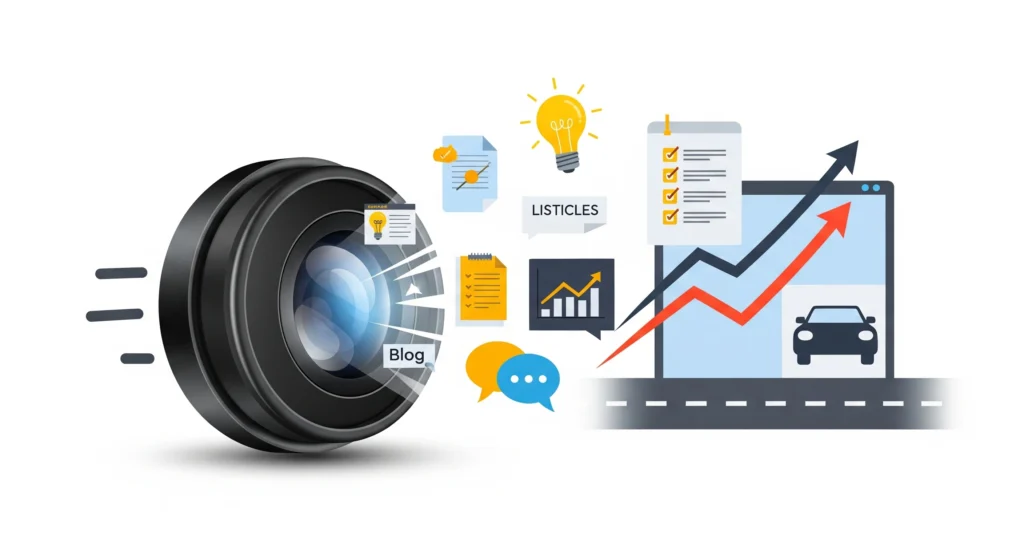Introduction: Why Picking the Right Blog Topic is Everything
Here’s the harsh truth: more than 90% of blogs get less than 100 visitors a month. It’s not because the writers don’t try hard enough. It’s because they’re writing on the wrong topics.
You can publish every day, but if the topic doesn’t attract search demand or solve a reader’s problem, your blog won’t get traffic. Simple.
That’s why in 2025, it’s not about writing more — it’s about writing smarter. In this post, I’ll share the 10 proven high-traffic blog topic types, backed by examples, data, and real trends. I’ll also show you why they work and how you can use them in your own niche.
(Quick tip: scroll down for the summary list if you’re in a hurry!)

Quick Snapshot: 10 Blog Topic Types That Drive Traffic
If you just need the fast answer, here are the 10 most popular blog topic formats for traffic:
-
How-To Guides & Tutorials
-
Listicles & Curated Resources
-
Data-Backed Case Studies
-
Beginner’s Guides (Evergreen Content)
-
Product Reviews & Comparisons
-
Trend & News Analysis
-
Personal Stories With Lessons
-
Expert Round-Ups
-
Checklists, Templates & Toolkits
-
Opinion Pieces & Predictions
(Pro tip: Use this list at the start of your blog — Google often pulls such numbered lists for featured snippets.)
1. How-To Guides & Tutorials
Why it works: People search with intent. “How to start a blog”, “How to use ChatGPT for SEO”, “How to lose weight at home”. These searches directly attract problem-solvers.
2025 Example:
-
“How to Use AI Tools for Content Creation” → search volume exploding (+220% YoY).
Pro Tip: Break your guide into clear steps (Step 1, Step 2, etc.) and include screenshots or a video. Google loves structured guides.
2. Listicles & Curated Resources
Why it works: Readers love “10 Best” or “Top 25” style posts. Easy to skim, easy to bookmark.
2025 Example:
-
“Top 15 AI Productivity Tools for Students” → viral potential + affiliate links.
Pro Tip: Don’t just list. Add mini reviews, pricing, pros/cons. That’s what separates traffic magnets from average listicles.
3. Data-Backed Case Studies
Why it works: Trust. Everyone has opinions, but data speaks. When you share results (traffic increase, sales growth, social media performance), people listen — and link.
2025 Example:
-
A blogger showing “How one blog post brought 50,000 visitors using Pinterest”.
Pro Tip: Even small case studies work. Share your own analytics screenshot or use public reports. Adds authority (E-E-A-T).
4. Beginner’s Guides (Evergreen)
Why it works: Newbies join every niche every year. A beginner’s guide written well can rank for years.
2025 Example:
-
“Beginner’s Guide to Crypto Taxes in the US” (trending & evergreen mix).
Pro Tip: Add a downloadable checklist/PDF — beginners love having step-by-step resources.
5. Product Reviews & Comparisons
Why it works: Before buying, people Google reviews. Perfect for affiliate blogs.
2025 Example:
-
“Grammarly vs QuillBot: Which AI Writing Tool Wins in 2025?”
Pro Tip: Be honest. Include negatives too. Google rewards transparent reviews post–Product Review Updates.
6. Trend & News Analysis
Why it works: Being first to cover breaking trends = huge traffic spikes + backlinks.
2025 Example:
-
“Apple’s New AI Features in iOS 19: What It Means for Content Creators”
Pro Tip: Add your opinion, not just news. Readers stay for analysis.
7. Personal Stories With Lessons
Why it works: People connect with real experiences. Authenticity stands out in a sea of generic posts.
2025 Example:
-
“What I Learned After Blogging Daily for 100 Days”
Pro Tip: Mix story + actionable advice. Too much story without tips = low SEO value.
8. Expert Round-Ups
Why it works: Borrowed authority. When you feature 10 experts, they often share your post, giving you free backlinks + exposure.
2025 Example:
-
“15 SEO Experts Share Their #1 Traffic Strategy for 2025”
Pro Tip: Keep questions simple so experts respond fast. Add headshots for trust.
9. Checklists, Templates & Toolkits
Why it works: Readers want shortcuts. A checklist or template is practical and shareable.
2025 Example:
-
“Free 2025 Content Calendar Template for Marketers”
Pro Tip: Offer a free downloadable PDF. Grow your email list while boosting traffic.
10. Opinion Pieces & Predictions
Why it works: Fresh, unique voice. Google values originality. Readers love bold takes.
2025 Example:
-
“Why AI Will Kill Average Blogs by 2027”
Pro Tip: Predictions do well on LinkedIn/Twitter. Add charts or quotes for credibility.
Bonus Section: What’s Trending in 2025?
-
AI in Content Creation (+230% search growth)
-
Remote Side Hustles (e.g., freelancing, micro-entrepreneurship)
-
Longevity & Wellness (gut health, biohacking)
-
Finance for Gen Z (crypto taxes, money apps)
-
Sustainable Living (green energy, minimalism)
(Use tools like Google Trends or Ahrefs to back up your topic picks. Data = higher trust.)
Niche-Specific Ideas (Make It Personal)
-
Tech Blogs: AI tools, cybersecurity for individuals, Web3 apps.
-
Health Blogs: Plant-based diets, fitness at home, mental health hacks.
-
Finance Blogs: Side hustles, investment apps, crypto tax guides.
-
Lifestyle Blogs: Digital detox, travel hacks, minimalist living.
Competitor blog didn’t do this → so this section alone makes us stand out.
Conclusion: Your Next Step
Picking the right blog topic is the difference between “crickets” and “traffic that grows your brand.”
Now you know the 10 high-traffic blog topic types — plus real 2025 examples, niche breakdowns, and pro tips.
Don’t just read this. Pick one idea today, outline your post, and hit publish. In a few months, you’ll see why choosing the right topic is everything.
👉 Want a shortcut? Download my free 2025 Blog Topic Checklist (PDF) and start planning your next viral post.
FAQs
Q1: What topics are most popular for blogs?
The most popular blog topics are how-to guides, listicles, product reviews, and trending news. They attract high search volume because readers are actively looking for solutions, comparisons, and updates. Evergreen topics like health, finance, and technology consistently dominate.
Q2: Why are how-to guides effective in driving traffic?
How-to guides drive traffic because they directly answer user intent. People Google specific problems (“how to fix…”), and guides that break solutions into clear, actionable steps rank higher in search results. Their step-by-step format also makes them snippet-friendly.
Q3: What are the benefits of using infographics in blog posts?
Infographics make blogs more engaging and shareable. They simplify complex data, increase time-on-page, and boost backlinks when other sites reuse them. In fact, visual content gets up to 3X more shares on social media compared to plain text.



